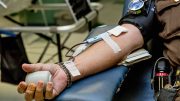High levels of hate violence against LGBTQ and HIV-affected communities continued last year, according to the new report, Lesbian, Gay, Bisexual, Transgender, Queer, and HIV-Affected Hate Violence 2013, from the National Coalition of Anti-Violence Programs (NCVAP). The 135-page report draws on data collected from 14 anti-violence programs in 13 U.S. states and Puerto Rico. During 2013, the states with anti-violence programs that reported data were Arizona, California, Colorado, Illinois, Kansas, Massachusetts, Michigan, Minnesota, Missouri, New York, Ohio, Texas, and Vermont.
The report noted the following trends in hate violence during 2013:
- Although the 2,001 total reported incidents of anti-LGBTQ violence was about the same in 2013 as in the previous year, there was a 21% increase in physical hate violence.
- Transgender women, people of color, and gay men had the highest risk of homicide during 2013.
- Transgender women, undocumented people, transgender people, people of color, and gay men suffered the most severe violence.
- Fewer survivors reported hate violence to the police, and those reporting violence were met with increased police hostility.
“What emerges clearly in the findings of this year’s report is that many of the people at risk for the most severe hate violence are at the intersection of multiple forms of oppression and discrimination, including racism and citizenship status,” said Aaron Eckhardt, training and technical assistance director at the Buckeye Region Anti-Violence Organization in Ohio. “Anti-LGBTQ hate violence can no longer be viewed in isolation from other forms of violence that our community members are experiencing based on their identities.” [pullquote]”What emerges clearly in the findings of this year’s report is that many of the people at risk for the most severe hate violence are at the intersection of multiple forms of oppression and discrimination, including racism and citizenship status.” —Aaron Eckhardt[/pullquote]
Fewer Youth Are Sexually Active, But Condom Use Is Down Among Those Who Are
The proportion of high school students who have ever had sexual intercourse declined from 54% in 1991 to 47% in 2013, according to data from the new Centers for Disease Control and Prevention (CDC) report newly released Youth Risk Behavior Surveillance – United States, 2013. In addition, the percentage of students who reported being currently sexually active – meaning that they had sexual intercourse during the 3 months prior to completing the YRBS survey – fell from 38% in 1991 to 34% in 2013. However, the survey also indicated that, among students who are currently sexually active, fewer used a condom the last time they had sexual intercourse (59%) in 2013 than did the sexually active students a decade earlier (63%). “This trend leaves more students vulnerable to HIV, STDs, and unintended pregnancy,” according to Dr. Stephanie Zaza, the director of the Division of Adolescent Health in CDC’s National Center for HIV/AIDS, Viral Hepatitis, STD, and TB Prevention.
The YRBS survey is conducted every two years among a nationally representative sample of high school students. Participation in the survey is voluntary, and the responses are anonymous. Over 13,000 U.S. high school students participated in the 2013 national survey. The CDC’s 172-page 2013 YRBS Report includes national YRBS data, as well as data from surveys conducted in 42 states and 21 large urban school districts.
In addition to sexual risk behaviors, the survey monitors five other categories of health-risk behaviors that contribute significantly to the leading causes of death, disability, and social problems among youth and adults in the U.S., including:
- unintentional injuries and violence;
- tobacco use;
- alcohol and other drug use;
- unhealthy dietary behaviors; and
- physical inactivity.
Many Plans Offered Through the Health Insurance Marketplace Impose High Costs on Persons Living with HIV/AIDS, New Report Finds
In recent weeks, health advocates have claimed that some of the plans offered through the Affordable Care Act (ACA) Health Insurance Marketplace are imposing excessive and discriminatory costs on people living with HIV/AIDS. On May 29, the National Health Law Program and The AIDS Institute filed a complaint with the U.S. Department of Health and Human Services’ Office for Civil Rights asking federal officials to take action to end prescribing drug pricing that discriminates against HIV-infected persons. According to the complaint, four Florida insurers have violated the provisions of the ACA and federal civil rights laws by structuring their prescription drug policies in a way that discourages HIV-infected persons from choosing their plans. An analysis conducted by Avalere Health with support from the Pharmaceutical Research and Manufacturers of America provides evidence that such high copays for HIV drugs are a common feature of many plans offered through the Marketplace. [pullquote]…the National Health Law Program and The AIDS Institute filed a complaint with the U.S. Department of Health and Human Services’ Office for Civil Rights asking federal officials to take action to end prescribing drug pricing that discriminates against HIV-infected persons. According to the complaint, four Florida insurers have violated the provisions of the ACA and federal civil rights laws by structuring their prescription drug policies in a way that discourages HIV-infected persons from choosing their plans.[/pullquote]
In its analysis of 123 plans from all U.S. states, Avalere looked at co-insurance levels for four classes of HIV drugs as well as drugs used for other chronic conditions, including cancers, diabetes, and multiple sclerosis. They found that, for the four classes of HIV drugs, between 27% and 39% of the plans studied placed every HIV drug, including generics, on the highest drug-pricing tiers in which patients are charged at least 30% in co-insurance and most charge more than 40%.
AIDS advocates responded quickly to the analysis. “We want the ACA to work, and we want it to work for people living with HIV/AIDS and others with chronic health conditions,” noted Carl Schmid, deputy executive of The AIDS Institute. “But shifting the cost of medications to the patients is not only blatant discrimination but can lead to poorer health outcomes, since beneficiaries will not be able to afford and access their life-saving medications.”
The AIDS Institute recommends that the Obama Administration take the following actions to address high medication costs and copays in insurance plans:
- Review plans and enforce the ACA non-discrimination protections in order to weed out the bad plans;
- Limit patient cost-sharing for medications to nominal amounts such as $10, $20, or $50 per drug, consistent with typical employer-based and marketplace plans; and
- Require plans to disclose clearly and fully the medication costs for patients, detailing real amounts the patient is expected to pay, rather than hiding these cost burdens with percentages.
ACT UP New York Releases “Atlanta Principles,” Challenging CDC to Bolster HIV Prevention Efforts
In response to high and rising rates of HIV infection among gay, bisexual, and other men who have sex with men (MSM) and transgender women in the CDC’s home city of Atlanta and elsewhere in the U.S., the advocacy group ACT UP New York recently released the Atlanta Principles, challenging the agency to bolster and expand its HIV prevention efforts.
In particular, the Atlanta Principles call on CDC to take action in the following areas:
- Sexually frank HIV prevention messaging: Rewrite content guidelines to allow the production and promotion of sexually explicit materials in the interest of public health.
- Sex education in schools: Issue basic sexual education guidelines that normalize sex as part of a healthy life, and abandon fear-based prevention messaging.
- Treatment as prevention (TasP): Educate HIV-infected persons and the general public about the prevention benefits of HIV treatment.
- Pre-exposure prophylaxis (PrEP) and post-exposure prophylaxis (PEP): Expand the information offered about these biomedical approaches to prevention through educational materials and events targeting populations at high risk for HIV infection and the medical providers who serve them.
- HIV prevention funding: Target prevention funding to populations at the greatest risk for infection, fund new prevention efforts, and continue funding older approaches that have a record of success.
- HIV testing: Expand testing sites beyond traditional points of care, address obstacles to testing, and train providers on how to screen for acute HIV infection.
- HIV epidemiology: Collect more detailed HIV surveillance data on affected populations, including transgender women and men, sex workers, young injection drug users, homeless women, and women in abusive relationships; and retool National HIV Behavioral Surveillance to improve and make better use of the data collected.
- Relationships with HIV-affected communities: Partner with the communities most affected by HIV and “nurture their organizations so they can be full partners in preventing new HIV infection and connecting people to care and wider services.”
CDC Rolls Out “Start Talking. Stop HIV.” Campaign
In May, CDC launched Start Talking. Stop HIV. – a national prevention campaign for gay and bisexual men “that promotes open communication about a range of HIV prevention strategies for sexual partners.” The campaign, which features gay and bisexual men from across the U.S., encourages men in all types of relationships to talk about HIV testing, their HIV status, condom use, and medicines that help prevent and treat HIV: pre- and post-exposure prophylaxis (PrEP and PEP) and antiretroviral therapy. CDC notes that “Start Talking. Stop HIV.” is designed to reach and influence men with messages that engage, inspire, and spark conversations between sexual partners about HIV prevention strategies. Campaign ads and resources, including a campaign website and Facebook page, provide gay and bisexual men with practical conversation tips and tools.
Antivirals and HIV Prevention Meeting Materials Now Available
The Fenway Institute (TFI) recently posted an extensive set of videos and presentation materials from its two-day meeting, “Antiretrovirals and HIV Prevention: A Conversation with Key Opinion Leaders About a New Paradigm” on TFI’s website. At the October 2013 event, researchers, policy-makers, leaders from HIV/AIDS and LGBT advocacy organizations, healthcare providers, and journalists examined recent research on PrEP and HIV treatment as prevention (TasP) and the implications of these developments for HIV prevention. The topics discussed included ongoing PrEP demonstration projects, approaches for educating the healthcare workforce about PrEP and TasP, and the responses of state and local health departments, community health centers, AIDS service organizations, and other community groups to the new paradigm for HIV prevention.
NASTAD and NCSD Publish Blueprint for Addressing Stigma in Black and Latino Gay Men
The National Alliance of State and Territorial AIDS Directors (NASTAD) and the National Coalition of STD Directors (NCSD) recently published Addressing Stigma: A Blueprint for HIV/STD Prevention and Care Outcomes for Black and Latino Gay Men. The 17-page report contains a series of recommendations designed to reduce the stigma that often prevents Black and Latino gay men and other men who have sex with men (MSM) from receiving optimal health care. The blueprint report looks at how stigma and other social determinants impact the HIV care continuum for Black and Latino MSM – examining “the bar before the bars,” which explores all the issues facing these men prior to an HIV or STD diagnosis. “We know that Black and Latino gay men are not linked and retained in care as successfully as White gay men,” notes Julie Scofield, executive director of NASTAD. “One of the ways we can address this is by looking seriously at stigma and structural biases that prevent these men from achieving a higher degree of viral suppression.”
*Eric Brus is the Director of HIV Health Promotion of AIDS Action Committee. This report is produced by the Health Library of the AIDS Action Committee in collaboration with the New England AIDS Education and Training Center Minority AIDS Initiative Project. The full version is available online.








